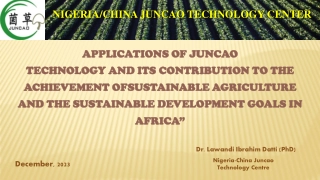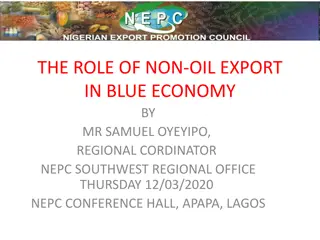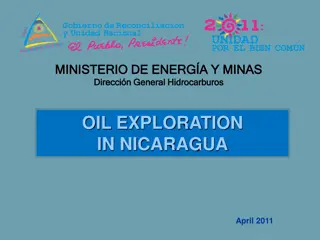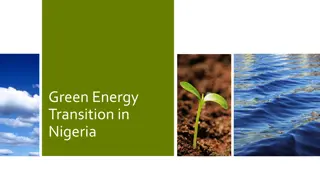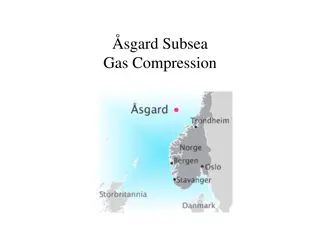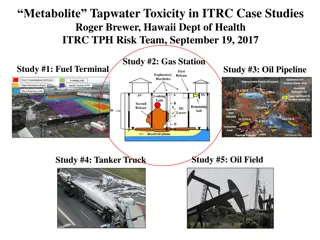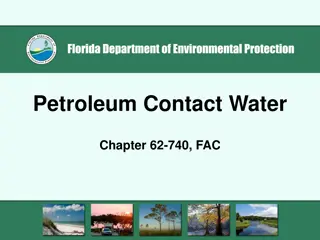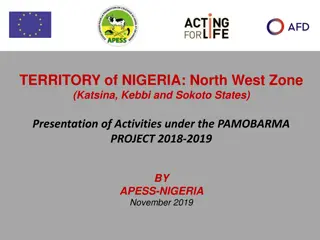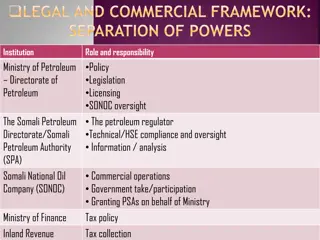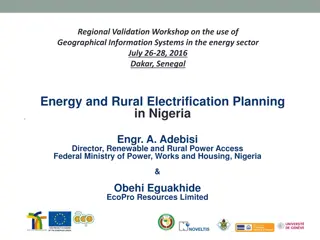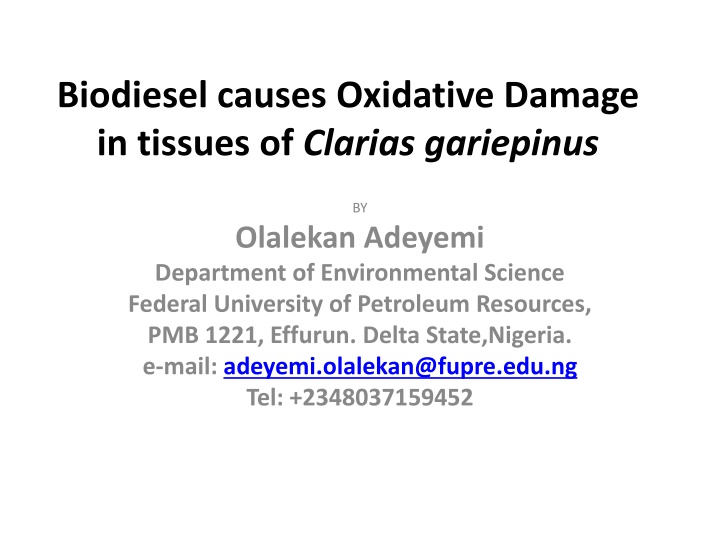
Biodiesel Induced Oxidative Damage in African Catfish Tissues
This study by Olalekan Adeyemi explores the impact of biodiesel, specifically from palm kernel oil, on the antioxidant levels in the tissues of African catfish (Clarias gariepinus). The research reveals a significant decrease in antioxidant status in catfish exposed to biodiesel-contaminated water, highlighting potential threats to aquatic life from alternative fuel sources. Despite the adverse effects on antioxidant levels, the haematological properties of the fish remained unaffected, emphasizing the importance of toxicology studies in assessing the environmental impact of alternative fuels.
Download Presentation

Please find below an Image/Link to download the presentation.
The content on the website is provided AS IS for your information and personal use only. It may not be sold, licensed, or shared on other websites without obtaining consent from the author. If you encounter any issues during the download, it is possible that the publisher has removed the file from their server.
You are allowed to download the files provided on this website for personal or commercial use, subject to the condition that they are used lawfully. All files are the property of their respective owners.
The content on the website is provided AS IS for your information and personal use only. It may not be sold, licensed, or shared on other websites without obtaining consent from the author.
E N D
Presentation Transcript
Biodiesel causes Oxidative Damage in tissues of Clarias gariepinus BY Olalekan Adeyemi Department of Environmental Science Federal University of Petroleum Resources, PMB 1221, Effurun. Delta State,Nigeria. e-mail: adeyemi.olalekan@fupre.edu.ng Tel: +2348037159452
ABSTRACT Alternative fuels have become more prominent today because of environmental Biotechnology studies have improved the quality and yield of alternative fuels from both edible and inedible plant sources. Due to the increase in the use of alternative fuels, toxicology studies have become imperative to determine whether alternative fuels will affect the biochemistry of aquatic organisms. concerns.
ABSTRACT In this study, biodiesel in different concentrations (0.0, 0.1, 0.25 %v/v) was introduced into water samples of same volume containing species of Clarias gariepinus (African cat fish). The 3 groups of fish placed in (0.0 0.1, 0.25)%v/v biodiesel-contaminated water were sacrificed after 30hours and enzymic and non-enzymic antioxidants (GSH, SOD, CAT, and MDA) as well as haematological properties were analyzed.
ABSTRACT Specific activity of SOD was found to be 8.55 0.89, 6.25 0.45 and 6.22 0.55 in the kidney of Control, 0.1%v/v respectively. Similarly, specific activity of catalase was found to be 18.24 1.89, 15.30 0.76 and 13.39 1.27 in the gills of Control, 0.1%v/v and 0.25%v/v fish respectively. Conversely, the haematological Control was not significantly different from those of 0.1%v/v and 0.25%v/v fish. and 0.25%v/v fish property of
ABSTRACT Results from this study showed significant decrease in the antioxidant status of cat fish from biodiesel contaminated water, however, haematological properties of the fish were not affected. This study revealed that biodiesel from palm kernel oil poses threat to aquatic life forms.
AIMS AND OBJECTIVES The purpose of this study is to evaluate the effect of biodiesel produced from PKO on enzymic and non-enzymic antioxidant of some selected tissues of fish using African cat fish (Clarius gariepinus) as a model.
PRODUCTION OF BIODIESEL Palm kernel oil was purchased at the local market in Effurun, Nigeria. 100g PKO was used for the transesterification process as described [6-7] The ethanol used (99% pure) is an analytical grade with boiling point of 78oC; while the NaOH used was also an analytical grade product of Aldrich Chemicals, England.
PRODUCTION OF BIODIESEL The blender used was a Dry and Wet mill Blender with a clear glass (1,250 cc capacity) containers and stainless steel cutting blades. Other major materials used include scales, translucent white plastic container with bung and screw-on cap, funnels, PET bottles and thermometer.
PRODUCTION OF BIODIESEL 20.0g of ethanol was measured and poured into a plastic container after which 1.0g of NaOH was carefully added. The container was swirled round thoroughly for about 2 min repeatedly about six times for complete dissolution of NaOH in the ethanol to form sodium ethoxide. 100.0 g of PKO was measured out, pre-heated to 60oC in a beaker and poured into the blender.
PRODUCTION OF BIODIESEL Sodium ethoxide from the plastic container was carefully poured into the PKO, the blender lid was secured tightly and the blender switched on while agitation in the blender was maintained for 90 min. The mixture was poured from the blender into a PET bottle for settling and the lid was screwed on tightly.
PRODUCTION OF BIODIESEL The reaction mixture was allowed to stand overnight while phase separation occurred by gravity settling. The PKO biodiesel was carefully decanted into a PET bottle leaving the glycerol at the base. The biodiesel was washed with water. The procedure was replicated three times and average biodiesel yield as well as glycerol yield was measured on weight basis
STATISTICAL ANALYSIS All numerical results were obtained from the three (3) groups (control and treated). Data obtained were presented as mean SEM and subjected to statistical analysis using a one way analysis of variance (ANOVA) by employing the method of Steel and Torrie [8]. Significant difference between the treatment means was determined at 95% confidence level using Duncan s Multiple range test [9].
RESULTS Haematological properties of C. gariepinus cultivated in contaminated water are presented in Table 1. The GSH concentrations of tissues of experimental African cat fish (Clarias gariepinus) are presented in Table 2. Table 3 shows activity of SOD of Clarias gariepinus cultivated in biodiesel contaminated water. The activity of catalase in tissue of fish is presented in Table 4. The MDA concentrations of tissues of Africa catfish are presented in Table 5
Table 1: Haematological properties of Clarias gariepinus cultivated in water contaminated with biodiesel from PKO Haematological parameters RBC (x106/mm3) Hb (g/dL) MCV ( 3) MCH ( g) MCHC (%) PCV (%) WBC (x103/mm3) 25.75 1.53a Neutrophils (%) Eosinophils (%) Basophils (%) Lymphocytes (%) 23.63 1.78a Monocytes (%) Group A Group B Group C 2.71 0.10a 5.76 0.54a 58.99 2.45a 14.30 0.86a 16.74 1.11a 21.32 1.23a 2.69 0.12a 5.23 0.56a 56.78 2.34a 14.34 0.73a 15.98 0.99a 21.56 1.21a 26.01 1.13a 3.25 0.52a 0.00 0.00a 0.32 0.01a 23.56 1.67a 13.22 1.33a 2.72 0.31a 5.56 0.46a 56.39 2.07a 13.97 1.06a 16.58 1.02a 21.12 1.48a 27.03 1.72a 3.33 0.65a 0.00 0.00a 0.32 0.01a 23.95 2.00a 13.09 1.51a 3.48 0.34a 0.00 0.00a 0.34 0.01a 13.20 1.02a
Table 2: Concentration of reduced glutathione (g/mg tissue) of liver and blood of experimental Clarias gariepinus Group Liver Blood A 10.23 1.24a 18.23 1.12a B 9.21 1.43ab 18.64 1.23a C 7.56 1.11b 18.52 1.19a
Table 3: Specific activity of superoxide dismutase (Unit/mg protein) of selected Tissues of experimental Clarias gariepinus Group Brain Liver Kidney Gill A 3.21 0.45a7.86 1.43a8.55 0.89a5.23 0.98a B 2.98 0.36a6.42 1.29a6.25 0.45b3.24 0.87b C 3.02 0.68a6.13 1.11a6.22 0.55b2.89 0.89b
Table H2O2 decomposed/min/mg protein) of selected tissues of experimental Clarias gariepinus 4: Specific activity of catalase ( mole of Group Brain Liver Kidney Gill A 1.58 0.18a 15.96 1.00a 18.54 2.34a 18.24 1.89a B 1.46 0.09a 13.22 0.75ab 13.77 1.69b 15.30 0.76b C 1.39 0.11a 12.56 0.92b 11.78 1.95b 13.39 1.27c
Table 5: Concentration of malondialdehyde (nmol/mg tissue) of selected tissues of experimental Clarias gariepinus Group Brain Liver Kidney Gill Serum A 0.37 0.01a0.21 0.01a0.23 0.02a0.10 0.02a0.22 0.02a B 0.36 0.02a0.14 0.01b0.17 0.02b0.07 0.01b0.21 0.01a C 0.37 0.02a0.12 0.01b0.16 0.01b0.06 0.01b0.19 0.01a
DISCUSSION The biochemical characteristics in fish has become an important means of understanding normal, pathological processes and toxicological impacts [3]. Haematological alterations are one of the first detectable and quantifiable environmental change [10]. Haematological and biochemical profiles of blood can provide important information about the internal environment of the organism [11]. evaluation of haematological and responses to
DISCUSSION The observed significant reduction in the GSH level of the liver of test fish relative to control revealed the likelihood of biodiesel to induce oxidative stress in the tissue. In this study, biodiesel quickly depletes hepatocyte glutathione levels, it is viewed as a potential agent of lipid peroxidation. Reduction of SOD activity may be due to enzyme inhibition of by biodiesel and/or its metabolites.
DISCUSSION The observed changes in CAT activity were concentration dependent, decreasing with increasing concentration of biodiesel. It could be deduced that the biodiesel, like fuel diesel, is capable of generating ROS which may predispose to oxidative stress.
DISCUSSION The significant increase in the levels of MDA lend credence to the view that biodiesel caused a reduction in the total antioxidant status of catfish by generating reactive oxygen species.
CONCLUSION In conclusion, toxicological effect of biodiesel on haematological properties is limited. However, the role of biodiesel in the reduction of antioxidant status of catfish is indicative of oxidative stress caused by reactive oxygen species. I wish to submit that adequate precautions must be observed by biodiesel production plants to avoid spillage of biodiesel into water bodies.


